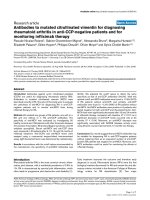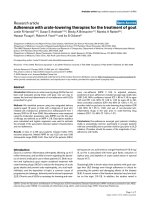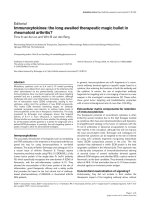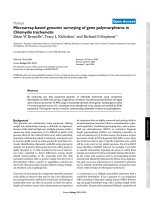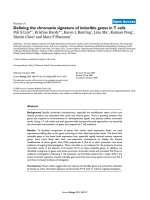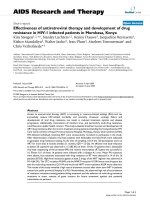Báo cáo y học: "Adherence to anti-retroviral therapy among HIV patients in Bangalore, India" pps
Bạn đang xem bản rút gọn của tài liệu. Xem và tải ngay bản đầy đủ của tài liệu tại đây (240.53 KB, 8 trang )
BioMed Central
Page 1 of 8
(page number not for citation purposes)
AIDS Research and Therapy
Open Access
Research
Adherence to anti-retroviral therapy among HIV patients in
Bangalore, India
Mary B Cauldbeck*
1
, Catherine O'Connor
2
, Mortimer B O'Connor*
3,4
,
Jean A Saunders
5
, Bhimasena Rao
6
, V G Mallesh
6
, Nagendrappa Kotehalappa
Praveen Kumar
6
, Gurushanthappa Mamtha
6
, Claire McGoldrick
7
,
Robert BS Laing
7
and Kadappa Shivappa Satish
6
Address:
1
The School of Medicine, University of Aberdeen, Aberdeen, Scotland, UK,
2
GU/STD Clinics, Department of GU/STD Medicine, Mid-
Western Regional Hospital, Limerick, Ireland,
3
Department of Medicine, South Infirmary – Victoria University Hospital, Cork, Ireland,
4
The School
of Medicine, University College Cork, Cork, Ireland,
5
Department of Mathematics and Statistics, University of Limerick, Limerick, Ireland,
6
Department of Respiratory and HIV Medicine, Rajajinagar and Wockhardt Hospital and Heart Institute, Bangalore, India and
7
Infection Unit,
Department of Infectious Diseases, Aberdeen Royal Infirmary, Aberdeen, Scotland, UK
Email: Mary B Cauldbeck* - ; Catherine O'Connor - ;
Mortimer B O'Connor* - ; Jean A Saunders - ; Bhimasena Rao - ;
V G Mallesh - ; Nagendrappa Kotehalappa Praveen Kumar - ;
Gurushanthappa Mamtha - ; Claire McGoldrick - ;
Robert BS Laing - ; Kadappa Shivappa Satish -
* Corresponding authors
Abstract
Introduction: Human Immunodeficiency Virus (HIV) has an estimated prevalence of 0.9% in India (5.2 million). Anti-retroviral
drugs (ARV) are the treatments of choice and non-adherence is an important factor in treatment failure and development of
resistance, as well as being a powerful predictor of survival. This study assesses adherence to ARV in HIV positive patients in
Bangalore, India, a country where only 10% of those who need therapy are receiving it.
Methods: A cross-sectional anonymous questionnaire survey of 60 HIV antibody positive patients was carried out with patients
attending HIV outpatient services at two centres: The Chest and Maternity Centre, Rajajinagar, and Wockhardt Hospital and
Heart Institute, Bangalore. Consent was obtained. Translation was done by a translator and doctors where required. Data was
analysed using SPSS statistical analysis.
Results: A response rate of 88% (53/60) was achieved. The mean patient age was 39.98 years, with 50% aged 30–40, and 73.6%
of participants being male. Mean family size was 4.8 (1–13). 21% lived less than 50 kms and 21% greater than 400 kms from clinic.
60% reported they were fully adherent. Adherence was statistically significantly linked to regular follow-up attendance (70.5%,
p = 0.002). No other results were statistically significant but trends were found. "100% adherence" trends were seen in older
patients, male gender, those from larger families, those who had a previous AIDS defining illness, those taking fewer tablets, and
without food restrictions. Commonest side-effects causing non-adherence were metabolic reasons (66%) and GI symptoms
(50%). No trends were seen for education level, family income, distance travelled to clinic, time since diagnosis, or time on ART.
Conclusion: Regular attendance for follow up was statistically significant for 100% lifetime adherence. Positive trends were
seen in those in larger families, older, those who had AIDS defining illness, simple regimes, and without side-effects. Education,
income, distance travelled and length of time diagnosed or treated had no effect on adherence.
Published: 28 April 2009
AIDS Research and Therapy 2009, 6:7 doi:10.1186/1742-6405-6-7
Received: 3 June 2008
Accepted: 28 April 2009
This article is available from: />© 2009 Cauldbeck et al; licensee BioMed Central Ltd.
This is an Open Access article distributed under the terms of the Creative Commons Attribution License ( />),
which permits unrestricted use, distribution, and reproduction in any medium, provided the original work is properly cited.
AIDS Research and Therapy 2009, 6:7 />Page 2 of 8
(page number not for citation purposes)
Introduction
Human Immunodeficiency Virus (HIV) affects 40.3 million
people worldwide [1]. Sub-Saharan Africa, with an esti-
mated 25.8 million carriers, has the greatest burden of dis-
ease (64%) [1,2]. The prevalence is estimated at 5–15% in
most other Sub-Saharan countries [1,2]. Asia has an esti-
mated prevalence in the region of 8.3 million, with 5.2
million being in India, giving an Indian adult HIV preva-
lence of 0.9% [3]. This compares to an estimated 58,300
cases in the United Kingdom (UK) at the end of 2004 [4].
In India, HIV prevalence tends to be higher in industrial-
ized states including Karnataka [1], with infection levels
of over 1% found in pregnant women in Andhra Pradesh,
Karnataka and Maharashtra in 2004 [1].
Worldwide, the major route of transmission is unpro-
tected heterosexual intercourse (>75%) [5,6]. This
accounts for the increasing number of women being
affected worldwide, including India. Homosexual sexual
intercourse is the second commonest route of transmis-
sion, with the exception of localised areas such as Sydney,
Australia [7]. The incidence in injection drug-users (IDU)
varies internationally. It is relatively low in the UK [8]
while it is up to 50% in Eastern Europe, Vietnam, north-
east India and China [2]. Eastern Europe has the fastest
growing IDU HIV positive incidence in the world at
present [1]. Unfortunately, approximately 5–10% of new
HIV infections, worldwide, are in children; >90% of these
are infected during pregnancy, birth or through breast-
feeding [2,9]. Most of these cases occur in Africa, the Car-
ibbean or South East Asia [2,9].
Combination therapies of anti-retroviral drugs (ARV) are
the treatment of choice in HIV, and non-adherence is a
main, if not the most important factor in treatment fail-
ure, and the development of resistance [10]. To make sure
that HIV treatment works effectively it is important that
the drugs are taken on time, every time i.e. 100% medica-
tion adherence. It can be hard to achieve 100% medica-
tion adherence, but Sethi AK and colleagues have
previously shown that it is "all or nothing" [11]. This
study showed that if medication adherence levels were
between 70% and 90% then there was an increased risk of
resistance forming [11]. In fact it would be better to take
no drugs at all than to have adherence of less than 90%
[11]. If 95% medication adherence is not achieved then
treatment success becomes precarious [12]. It has also
been demonstrated that a 10% higher level of adherence
results in a 21% reduction in disease progression [13].
These are founded on "Medication adherence" meaning
all drugs are taken on time, every time as prescribed by the
prescribing physician.
Concerns about incomplete medication adherence
among patients living in poverty have been an important
consideration in expanding the access to anti-retroviral
therapy (ART) [14]. The research into medication adher-
ence in poorer communities however tends to be centred
on research undertaken in sub-Saharan Africa. There is a
paucity of medical literature on adherence to ART in Asia,
however a study has been undertaken in Chennai, India
(n = 304) [15]. This study reported patient medication
adherence as "regular" in 74.3% of patients, with a signif-
icant minority being categorised as "irregular" (17.8%), or
"recently missed doses" (6.9%) [15]. Medication adher-
ence was not associated with any demographic variables
[15]. In Asia the number of people receiving ART rose
from 70,000 in 2003 to 180,000 at the end of 2005, how-
ever still only 1 in 6 people in need of ART in Asia are
receiving it and coverage is well below 10% in India
(which has more than 70% of Asia's total treatment
needs) [3]. With a growing prevalence of HIV across all
areas of Indian society there is a growing number needing
treatment and greater strain on services to provide ART.
This in turn means a greater number who potentially have
medication adherence issues and questions what facili-
tates medication adherence from an individual and public
health perspective. Some people debate that in treatment
stretched areas 100% medication adherent patients
should be treated over non-adherent patients.
In view of the high prevalence of HIV in India and the lack
of data surrounding medication adherence in this popula-
tion, it was decided to study adherence to ART issues
among a HIV positive population in Bangalore, India. The
aims of this study were to evaluate the adherence to ART
among HIV patients attending Out Patient clinics at The
Chest and Maternity Centre, Rajajinagar, and Wockhardt
Hospital and Heart Institute in Bangalore, India. Patients
were evaluated by eliciting demographics, treatment regi-
mens and side effects as well as subjective medication
adherence.
Methods
HIV antibody positive patients attending out-patient clin-
ics in two institutions, The Chest and Maternity Centre,
Rajajinagar, and The Wockhardt Hospital and Heart Insti-
tute, Bangalore, India were studied.
Participants were recruited intermittently but consecu-
tively while researchers and translators were in attendance
over a seven week period between 28
th
August and 30
th
September 2006. Both researchers and a translators were
required to be present for patient participation in the
study to achieve complete patient understanding and
avoid any misinterpretations. All patients presenting to
clinics, while researchers and translators were present,
were eligible for inclusion in the study and therefore
approached to participate. No incentives were offered to
patients approached for inclusion to limit any bias.
AIDS Research and Therapy 2009, 6:7 />Page 3 of 8
(page number not for citation purposes)
A cross-sectional self-administered anonymous question-
naire survey was administered to HIV antibody positive
patients on ART attending the Out Patient services at the
two centres. Patients themselves completed a paper for-
mat questionnaire, which was explained in detail prior to
completion. Each question in the 32-point questionnaire
was explained before completing the questionnaire and a
translator was present when the patients were completing
questionnaires to resolve any questions regarding the
questionnaire. Each of the 32-point questions were tick
box in format with area for written expansions where rel-
evant. A target of 60 patients to be studied was set.
Informed consent was obtained, and the number of
patients refusing recorded.
Questionnaires elicited patient demographics, treatment
regimens and side effects as well as subjective medication
adherence. Medication adherence was recorded as taking
all medications as prescribed by the prescribing physician
(All medications at correct time on correct day). Last
week, last month, last six month and lifetime adherence
was recorded.
Data was analysed using the statistical package SPSS. Chi-
square tests, Student's t tests, significance testing, and 95%
Confidence Interval formulation were carried out where
appropriate. Ethical approvals were prospectively received
in both centres.
Prior to commencement of the study a one-week pilot
study in the two units was undertaken to look for flaws in
the questionnaire.
Results
The response rate was 88% (53/60 agreeing to be
involved). Of the responding 53 patients 16 (30%)
refused to answer questions about individual and/or fam-
ily income. These patients were then omitted from statis-
tical analysis on the effect of income on medication
adherence.
The mean age was 39.98 ± 2 years, with males being older
(40.35 (range: 28–66 years) versus 38.4 (range: 27–60
years)), and 50% of participants aged between 30 and 40
years. 73.6% (n = 39) of participants were male and
26.4% (n = 14) female, with the mean family size of 4.8
(range: 1 – 13). There was a predominance of patients
from urban locations compared to rural locations (44
(83%) versus 9 (17%)), while 10 (21%) patients lived less
than 50 km from clinic, 8 (17%) 50 – 200 km, 20 (42%)
200 – 400 km, and 10 (21%) greater than 400 km form
clinic.
19% of patients missed their medications in the last week,
30% in the last month, 36% in the last six months, and
40% since commencing treatment, in a setting of a mean
time on ART of 2.75 years. Medication adherence was
recorded as taking all medications everyday as prescribed.
Due to difficulties in translation of the meaning of per-
centage (eg 90%), a mean and median time of 2.75 years
on ART for the cohort, no resistance testing available in
the centres, along with studies showing that >90% – 95%
medication adherence is required in successful HIV treat-
ment/resistance prevention, medication adherence for
analysis was taken as lifetime adherence with the gold
standard as 100% medication adherence since starting
ART.
Medication adherence was analysed under the areas of: 1
basic demographics, 2 system, health and treatment fac-
tors, and 3 study factors.
It was recorded on data analysis that regular clinic follow
up was the only statistical factor affecting medication
adherence (last week (p < 0.005), last month (p < 0.005),
last six month (p < 0.005) and lifetime (p = 0.002)) in this
cohort. Positive trends for medication adherence were
seen for increasing age, larger families, having previously
had an AIDS defining illness, smaller pill burden and less
medication side-effects experienced.
Table 1 and table 2 outline the principle findings of the
study.
Discussion
Overall 100% medication adherence was found to be
60.4% (n = 32), p-valve = 0.615. This was lower than
expected as other studies conducted in developing coun-
tries have shown a "regular" medication adherence of
74.3% [16]. Of the 39.6% who had missed a medication,
approximately 50% had missed a medication in the last
week, and 40% had missed because they had run out of
medications. Missed medications means not taking a pre-
scribed medication on any day as prescribed by the physi-
cian. Of the patients who had run out of tablets all lived
more than 250 km from the clinic. This may imply that
there is a lack of availability of medicines in some geo-
graphical areas. It is difficult to understand why medica-
tion adherence should be less in this sample although it
may have something to do with the criteria for measuring
medication adherence. During data collection for this
study only those with 100% medication adherence were
considered as adherent whereas in other studies the level
of medication adherence is calculated and a level above
95% is taken to be adherent i.e. missing one medication
in twenty is acceptable.
AIDS Research and Therapy 2009, 6:7 />Page 4 of 8
(page number not for citation purposes)
Older patients showed a tendency towards better medica-
tion adherence but not statistically significant (p = 0.325).
This may be related to older patients' familiarity with
medication usage and their increasing awareness of HIV as
a disease that requires optimal adherence [17]. It was
those aged less than 40 years in this study that showed the
poorest levels of medication adherence. Many other stud-
ies have also identified young age as a risk factor for poor
medication adherence especially in those under 35 years
[16,18].
Gender was not associated with medication adherence, in
our study, as is supported in a previous review article of 18
descriptive studies [19]. Surprisingly neither living in a
rural compared with an urban area nor travelling long dis-
tances to the clinic showed trends against medication
adherence (p = 0.479). It is difficult to draw conclusions
related to gender as there are few female in this study.
It has been shown in this study that attending for regular
follow-up with a doctor correlates with better medication
Table 1: Patient Demographics relative to adherence of medication regimens
Non adherent 100% Adherent *
Age Group (years)
• 20–30 3 (42.9%) 4 (57.1%)
• 31–40 14 (53.8%) 12 (46.2%)
• >40 4 (23.1%) 16 (76.9%)
Gender
• Male 15 (38.5%) 24 (61.5%)
• Female 6 (42.9%) 8 (57.1%)
Follow-up
• Regular # 13 (29.5%) 31 (70.5%)
• Irregular 8 (88.9%) 1 (11.1%)
Education Level
• Illiterate 2 (50%) 2 (50%)
• Primary/Secondary 9 (80%) 18 (20%)
• University 10 (45.5%) 12 (54.5%)
Individual Income (Rs/month)
• <5000 5 (45.5%) 6 (54.5%)
• 5000–19999 8 (27.3%) 15 (72.7%)
• >20000 7 (43.8%) 9 (56.3%)
Total Family Income (Rs/month)
• <5000 2 (33.3%) 4 (66.7%)
• 5000–19999 8 (50%) 13 (50%)
• >20000 8 (50%) 8 (50%)
Family Type
• Living alone 1 (100%) 0
• Nuclear 14 (41.2%) 20 (58.8%)
• Joint/Extended 6 (37.5%) 12 (62.5%)
Locality
• Rural 3 (33.3%) 6 (66.7%)
• Urban 18 (40.9%) 26 (59.1%)
Distance from Clinic (Km)
• <50 4 (33.3%) 6 (66.7%)
• 50–200 3 (37.5%) 5 (62.5%)
• 200–400 7 (25.0%) 13 (75.0%)
• >400 3 (30%) 7 (70.0%)
* Lifetime Adherence means taking all medications as prescribed since starting treatment.
# Regular follow up meaning more than 90% attendance at 3 monthly appointments
AIDS Research and Therapy 2009, 6:7 />Page 5 of 8
(page number not for citation purposes)
Table 2: Patient Medication adherence
Missed Medications in Lifetime* Yes
n – value (%)
No
n – value (%)
Ever Missed medications since starting ART
$
21 (39.6%) 32 (60.4%)
Missed medications
$
in the last 6 months 19 (35.8%) 34 (64.2%)
Missed medications
$
in the last month 16 (30.2%) 37 (69.8%)
Missed medications
$
in the last week 10 (18.9%) 43 (81.1%)
Patient perception of well-being
• Sick 3 (50.0%) 3 (50%)
• Stable 9 (39.1%) 14 (60.9%)
• Normal 9 (37.5%) 15 (62.5%)
Previous AIDS defining illness:
• Yes 9 (28%) 24 (72%)
• No 10 (50%) 10 (50%)
Ailments presently suffering from
• AIDS 8 (27.6%) 21 (72.4%)
• Well(none) 4 (44.4%) 5 (55.6%)
• Ill not AIDS 9 (60%) 6 (40%)
Time since Diagnosis (years)
• <1 2 (33.3%) 8 (66.7%)
• 1–4 8 (44.4%) 10 (55.6%)
• 5+ 13 (35%) 14 (65%)
Number of years since patient became ill
• < 1 yr 5 (57.1%) 8 (42.9%)
• 1–4 9 (39.1%) 14 (60.9%)
• 5+ 7 (35.7%) 10 (64.3%)
Time since starting ART (years)
• < 1 5 (50%) 8 (50%)
• 1–4 10 (35.7%) 18 (64.3%)
• 5+ 6 (50%) 6 (50%)
Number of tablets/day
• <5 7 (24.1%) 22 (75.9%)
• 5–9 10 (58.8%) 7 (41.2%)
• 10+ 3 (50%) 3 (50%)
Food Restriction
• Yes 12 (52.2%) 11 (47.8%)
• No 9 (30%) 21 (70%)
Temperature Restriction
• Yes 3 (60%) 2 (40%)
• No 18 (37.5%) 30 (62.5%)
Time Restriction
• Yes 12 (50%) 12 (50%)
• No 9 (31%) 20 (69%)
Perceived difficulty of regimen
• Simple 11 (33.3%) 22 (66.7%)
• Moderate 10 (50%) 10 (50%)
AIDS Research and Therapy 2009, 6:7 />Page 6 of 8
(page number not for citation purposes)
adherence (p = 0.002). Regular follow up being defined as
attending greater than 90% of 3 monthly appointments.
This may be due to continued counselling, patients being
able to express concerns about their health and medica-
tions, and receiving supplies their medications avoiding
running out.
Surprisingly literacy was not significantly associated with
lower medication adherence (p = 0.089). This has also
been shown by Cheng et al in a 2006 publication [20].
Verbal instructions to patients who are illiterate seem
equally as effective as written instructions which are given
to all patients.
One may assume that those of a higher social status and
income are more adherent to their ART. This was not seen
here, where we report neither a patient's individual
income (p = 0.786) nor their total family income (p = 0.9)
show any significant association regards 100% medica-
tion adherence. This was unexpected, as patients in India
must pay for their medications. A study undertaken in
Chennai, India found that almost all the participants dis-
cussed the cost of ART as a barrier, with many reporting
drug holidays, turning to family and/or friends or taking
drastic measures (i.e. selling family jewels, property) for
financial assistance [21]. It can be seen however that those
in the middle class earning between 5000–9999 Rs/
month (Approximately GB£60–125) seem to be better at
adhering with medications compared to the very rich and
very poor who seem to be less careful. It must be ques-
tioned if many of those who earned less than 5000 Rs/
month could actually afford to buy their medicines.
Due to the small sample size of this cohort it is difficult to
reach valid conclusions on whether family size or type is
associated with medication adherence. This question was
originally posed in order to determine whether lack of pri-
vacy within the household affected patient medication
adherence, as this is a known effect. On reflection, it
would have also been important to ask if other members
of the household knew of the patients HIV status in order
to analyse this fully. Looking at our results, however,
trends were seen, despite not significant, as medication
adherence was better with increasing numbers of family
members. This may be due to the fact that patient's family
members may be useful to remind patients to take their
tablets regularly, or to help to pay for medicines, or both.
Poorer medication adherence was also seen in those living
alone (p = 0.407). It may therefore be argued that
increased acceptance and understanding of the disease,
thus reducing social stigma, and knowledge of the disease
treatments may improve medication adherence.
Results did show a trend towards an increased reporting of
100% medication adherence in those interviewed with a
doctor as a translator. A study conducted by Hautzinger M
et al in 2006 showed that patients are more likely to
inform their doctor why they take, than why they do not
take, ART [22]. Only half of those who were non-adherent
told their physician the reason why they missed medica-
tions [22]. The reasons for not telling their physician
included feeling unable to discuss issues and anticipation
that the doctor would not support the decision [22].
Therefore using a doctor involved in a patient treatments
as a translator in this study and future studies may bias
results and should be avoided in the future.
Although patient perception of their own physical well-
being did not affect medication adherence statistically, it
was seen that 50% of those who reported themselves as
feeling 'sick' admitted to having missed medications in
the past. This supports the fact that missing more than 5%
of ART medications can lead to a more rapid decline into
ill health [14]. Of those who were suffering from an AIDS
defining illness at the time of the study, they were less
likely to skip tablets as they improved their health.
Being on ART for less than 6 months or for greater than 10
years was associated with the largest number of missed
medications, in this study. This finding is supported by
Andreo C. et al who found that a duration of treatment
greater than two years was associated with increased non-
adherence to ART [23]. Tablet and schedule burdens can
often, understandably, be assumed to affect any medica-
tion adherence. In this Indian cohort we saw a trend
towards increased 100% medication adherence in those
Any Side Effects
• None 9 (34.6%) 17 (65.4%)
• GI symptoms
@
6 (50%) 6 (50%)
• CNS 2 (40%) 3 (60%)
• Rash/Skin discolouration 0 3 (100%)
• Metabolic reasons (non-lipid)
^
2 (66.7%) 1 (33.3%)
• Lipid Problems 2 (50%) 2 (50%)
* Lifetime Adherence means taking all medications as prescribed since starting treatment.
$
Missed medications means not taking a prescribed medication on any day as prescribed by the physician.
@
GI symptoms = Gastrointestinal tract symptoms which include diarrhoea, nausea and vomiting.
^
Metabolic reasons include diabetes mellitus.
Table 2: Patient Medication adherence (Continued)
AIDS Research and Therapy 2009, 6:7 />Page 7 of 8
(page number not for citation purposes)
on less than 5 tablets per day (p = 0.054). The number of
times per day that tablets were taken was also analysed but
this yielded no associations. This may be because most
patients (37 out of 53) are taking once or twice a day reg-
imens as they have started their ART since the advent of
Highly Active ART. Older studies of medications adher-
ence showed that once daily or twice daily dosing would
give 95% medication adherence while three times per day
scheduling reduced it to 60% [24]. Food restrictions (p =
0.157), time restrictions (p = 0.259) and temperature
restrictions (p = 0.374) seemed to decrease medication
adherence as was seen in other studies [24], while those
that experience side-effects from their medications are
known to be 'risk patients' for non-adherence to ART [14],
as was shown in this study. However, the severity of the
side effects also seemed to be a factor. Those experiencing
milder side effects such as skin rash or skin discolouration
were more adherent to ART than those experiencing more
severe side effects such as metabolic effects.
From the findings of this study, we noted that patient's
holding their own notes makes follow up by professionals
difficult in out patient's clinic setting along with affecting
100% medication adherence. Therefore we recommend
the appointment of a person(s) to remind patients of their
regimens and recall them to clinic when arranged. The use
of mobile phones, which are becoming universally avail-
able, are a big help to communicate with patients directly.
A text or a call may be all that is necessary to achieve a
greater number achieving 100% medication adherence by
attending when arranged. The use of pill boxes, which are
filled weekly, may also be beneficial as they enable
patients to know with certainty that they have taken med-
icines.
Factors affecting lifetime medication adherence correlate
with factors affecting 1 week adherence, 1 month adher-
ence and 6 months adherence.
Conclusion
More people who do not attend regularly are less adherent
to ART from a 100% medication adherence perspective
then their dedicated counterparts. Greater medication
adherence was also seen in those who were older, male
gender, from larger families, have a previous AIDS defin-
ing illness, and taking less tablets in a day (especially <5
tabs). Patients without food, temperature or strict time
restrictions also did better.
There was no trend in 100% medication adherence when
comparing educational status, distance living from clinic
and length of time since diagnosis. There was, however, a
trend of non-adherence in those who were on ART for
longer (especially those >10 years experience).
This study shows that many patients in India are getting
ART but many have to travel long distances for it and have
to pay for medication. CD4+ analysis is easily available
but viral loads are not as freely available, and all tests have
a cost to the patient.
Further larger study into medication adherence among
Indian HIV patients is required, especially looking at the
impact of income and medication adherence. Future stud-
ies should also look at adherence on shorter time scales,
for adherence among Indian HIV patients, rather than life-
time adherence as in this study.
Competing interests
The authors declare that they have no competing interests.
Authors' contributions
MC, BR, GM, KP, DM, KS carried out the field work. COC,
MOC, JS carried out the statistical analysis. MC, COC,
MOC prepared the manuscript. MC, CM created the data-
base. MC, COC prepared the study design. RL, KS were
guarantors of the study.
Acknowledgements
The authors would like to thank all of the patients who took part in this
study. Without them this publication would not be possible. A special
thanks to the translators who helped in data collection.
References
1. AIDS epidemic update Joint United Nations Programme on
HIV/AIDS (UNAIDS) & World Health Organisation (WHO)
2005 [ />epi_update2005_en.pdf]
2. Lewthwaite P, Wilkins E: Natural History of HIV/AIDS. Medicine
2005, 33:6.
3. 2006 Report on the Global AIDS Epidemic [http://
data.unaids.org/pub/GlobalReport/2006/2006_GR_CH02_en.pdf]
4. The UK Collaborative Group for HIV and STI Surveillance: Mapping
the Issues: HIV and other Sexually Transmitted Infections in
the United Kingdom: 2005. London: Health Protection Agency
Centre for Infections; 2005.
5. Flectcher P, Griffin G, Kiselyeva Y, Margolis L, Romano J, Shattock R,
Wallace G: The nonnucleoside reverse transcriptase inhibitor
UC-781 inhibits human immunodeficiency virus type 1 infec-
tion of human cervical tissue and dissemination by migratory
cells. J Virol 2005, 79(17):11179-86.
6. Lacaille J, Lajoie J, Matte C, Roger M, Ward BJ, Zijenah LS: Function-
ally active HLA-G polymorphisms are associated with the
risk of heterosexual HIV-1 infection in African women. AIDS
2004, 18(3):427-31.
7. Volk JE, Prestage G, Jin F, Kaldor J, Ellard J, Kippax S, Grulich AE: Risk
factors for HIV seroconversion in homosexual men in Aus-
tralia. Sex Health 2006, 3(1):45-51.
8. Hope VD, Judd A, Hickman M, Sutton A, Stimson GV, Parry JV, Gill
ON: HIV prevalence among injecting drug users in England
and Wales 1990 to 2003: evidence for increased transmission
in recent years. AIDS 2005, 19(11):1207-14.
9. Centers for Disease Control and Prevention: HIV/AIDS surveillance
Report 1998, 10:1-40.
10. Turner BJ: Adherence to antiretroviral therapy by HIV-
infected patients. Journal of Infectious Disease 2002,
185(S2):S143-51.
11. Sethi AK, Celentano DD, Gange SJ, Moore RD, Gallant JE: Associa-
tion between adherence to antiretroviral therapy and
human immunodeficiency virus drug resistance. Clin Infect Dis
2003, 37(8):1112-8.
Publish with BioMed Central and every
scientist can read your work free of charge
"BioMed Central will be the most significant development for
disseminating the results of biomedical research in our lifetime."
Sir Paul Nurse, Cancer Research UK
Your research papers will be:
available free of charge to the entire biomedical community
peer reviewed and published immediately upon acceptance
cited in PubMed and archived on PubMed Central
yours — you keep the copyright
Submit your manuscript here:
/>BioMedcentral
AIDS Research and Therapy 2009, 6:7 />Page 8 of 8
(page number not for citation purposes)
12. Hoffmann C, Mulcahy F: Goals and Principles of Therapy – Erad-
ication, Cost, Prevention, Adherence. [medi
cine.com/textbook/haart/goals2.htm].
13. Khopkar U, Nischal KC, Saple DG: Improving adherence to
antiretroviral therapy. Indian J Dermatol Venereol Leprol 2005,
71(5):316-20.
14. Attaran A, Bangsberg DR, Buchan I, Cooper C, Guyatt GH, Mills EJ,
Nachega JB, Orbinski J, Rachlis B, Singh S, Thabane L, Wilson K, Wu
P: Adherence to antiretroviral therapy in sub-Saharan Africa
and North America: a meta-analysis. JAMA 2006,
296(6):679-90.
15. Safren SA, Kumarasamy N, James R, Raminani S, Solomon S, Mayer
KH: ART adherence, demographic variables and CD4 out-
come among HIV-positive patients on antiretroviral therapy
in Chennai, India. AIDS Care 2005, 17(7):853-62.
16. Murri R, Ammassari A, De Luca A, Cingolani A, Marconi P, Wu AW,
Antinori A: Self-reported nonadherence with antiretroviral
drugs predicts persistent condition. HIV Clin Trials 2001,
2(4):323-9.
17. Wutoh AK, Brown CM, Kumoji EK, Daftary MS, Jones T, Barnes NA,
Powell NJ: Antiretroviral adherence and use of alternative
therapies among older HIV-infected adults. J Natl Med Assoc
2001, 93(7–8):243-50.
18. Frank I: Once Daily HAART: toward a new treatment para-
digm. J Acquir Immune Defic Syndr 2002, 31(Suppl 1):S10-5. discus-
sion S24-5
19. Fogarty L, Roter D, Larson S, Burke J, Gillespie J, Levy R: Patient
adherence to HIV medication regimens: a review of pub-
lished and abstract reports. Patient Educ Couns 2002,
46(2):93-108.
20. Paasche-Orlow MK, Cheng DM, Palepu A, Meli S, Faber V, Samet JH:
Health literacy, antiretroviral adherence, and HIV-RNA sup-
pression: a longitudinal perspective. J Gen Intern Med 2006,
21(8):835-40.
21. Kumarasamy N, Safren SA, Raminani SR, Pickard R, James R, Krishnan
AK, Solomon S, Mayer KH: Barriers and facilitators to antiret-
roviral medication adherence among patients with HIV in
Chennai, India: a qualitative study. AIDS Patient Care STDS 2005,
19(8):526-37.
22. Kremer H, Ironson G, Schneiderman N, Hautzinger M: To take or
not to take: decision-making about antiretroviral treatment
in people living with HIV/AIDS. AIDS Patient Care STDS 2006,
20(5):
335-49.
23. Andreo C, Bertholon DR, Bouhnik AD, Rossert H, Soletti J, Spire B,
Moatti JP: Non-compliance in HIV-infected patients, sup-
ported by a community association. Sante Publique 2001,
13(3):249-262.
24. McNabb JJ, Nicolau DP, Ross J, Stoner JA: Patterns of adherence
to antiretroviral medications: the value of electronic moni-
toring. AIDS 2003, 17(12):1763-7.
